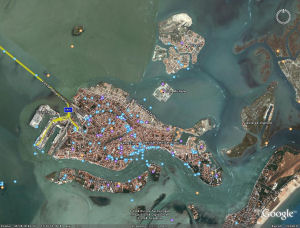
The train from Florence passed over the Tuscan countryside and crossed a causeway onto the island of Venice.

We gathered our suitcases and stepped from the station directly onto the square where the
‘vaporetto’ or water taxi, stops.
Crowds of people disembarking and embarking these boats did not make it an easy task with suitcases in tow, but we boarded and rode to the S. Zaccaria stop next to St. Mark’s Square.
Our accomodation was directly across the promenade, the Hotel Paganelli. What a location - 200 yards from the Grand Canal and a short two-bridges walk from the Piazza di S. Marco - St. Mark’s Square. We learned that this hotel often is fully booked over a year in advance!
Venice is a 1,500 year old city set in a lagoon located at the northern end of the Adriatic Sea. The city is a car-motorcycle-scooter-free medieval warren of 2,000 narrow alleys/streets on over 100 islands connected by 400 bridges. At one point during the Middle Ages, Venice was the premier trading and cultural center of Europe.
After arranging ourselves in our small room, we went out into Venice, first to St. Zaccaria Church and then for a short walk through narrow streets to St. Mark’s Square - the largest, most well known and impressive piazza in Venice.
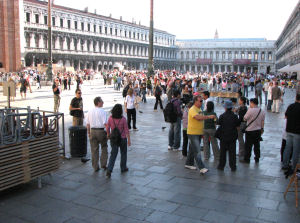
The pigeons! There are 1000’s of them! They are everywhere, with the largest number concentrated in the middle of the square under and on the tourists milling there. Tourists can purchase small packets of bird seed from vendors which attracts hordes of the creatures. The birds land on the pavement, on arms and hands, on shoulders and heads. It’s almost surreal. And they whiz by so close that you can feel the air shudder from their wing movements. 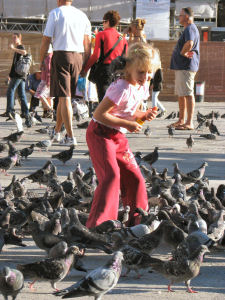
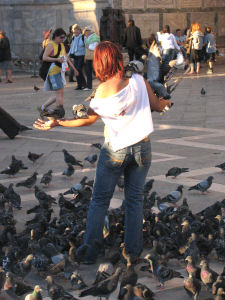
We walked about St. Mark’s Square stopping to listen to the four orchestras that take turns playing for the tourist crowd and thought about having a cup of coffee at Florian, where the first coffee was served in Italy, but shied awayfrom the €6 or $9 price tag!!
We walked the narrow streets around the Square until we found ourselves at a small park by the waterfront where we rested and ‘people watched.’ There are few of these parks in Venice It’s virtually all paved streets, buildings, and canals linked to each other and the lagoon. We strolled back to our hotel along the waterfront enjoying the sights of the gondolas, water taxis darting in and out of canals, vaporettos and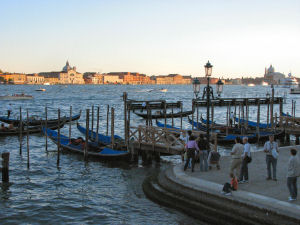
After dinner we strolled, again, into St. Mark’s Square and enjoyed the classical music of the restaurant bands. The music was broken by the sound of the two large automated bronze Moors, located on the top of one of the buildings, striking the bronze bell at 10 p.m. Then a short walk back to the hotel enjoying the lights of the islands reflecting off the lagoon with the taxis and gondolas at their moorings along the shore.
After breakfast at the hotel we walked to St. Mark’s Square to purchase entrance tickets to the Doge’s Palace. The building 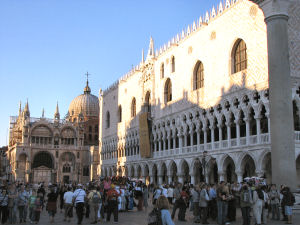
We walked away from the square and quickly were in areas of Venice where there were fewer tourists. Wonderful narrow lanes, small doors, many bridges over canals and crumbling walls of buildings. We found a church where a number of little shelters for stray animals was 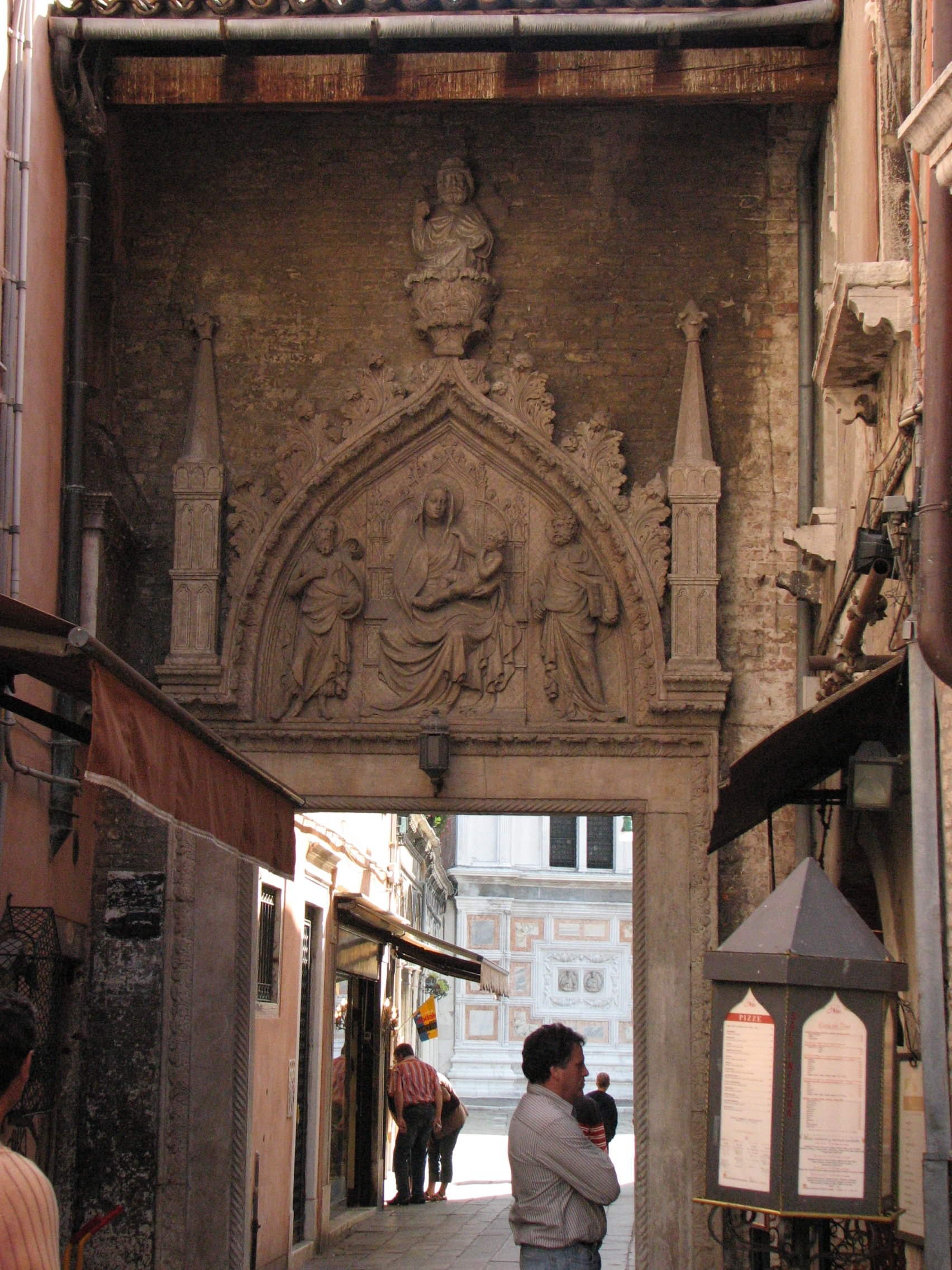
A little further on we found a supermarket near a small canal and went in. We purchased cheese, bread and lemon drink which we brought back to the hotel room for lunch.
Back to St. Mark’s Square where w e listened to some more music and managed to find the place to purchase the museum card. We immediately put it to use to see the paintings and sculptures of Venice during the 13 – 15th centuries found in the Archaeological museum. We saw an extraordinary number of paintings, Roman and Renaissance sculptures, navigational instruments, ancient maps and the library (started in the 1400’s). Exhausting! Back into the square and rode the elevator to the top of the bell tower or Campanille for a wonderful view of Venice and the square below.
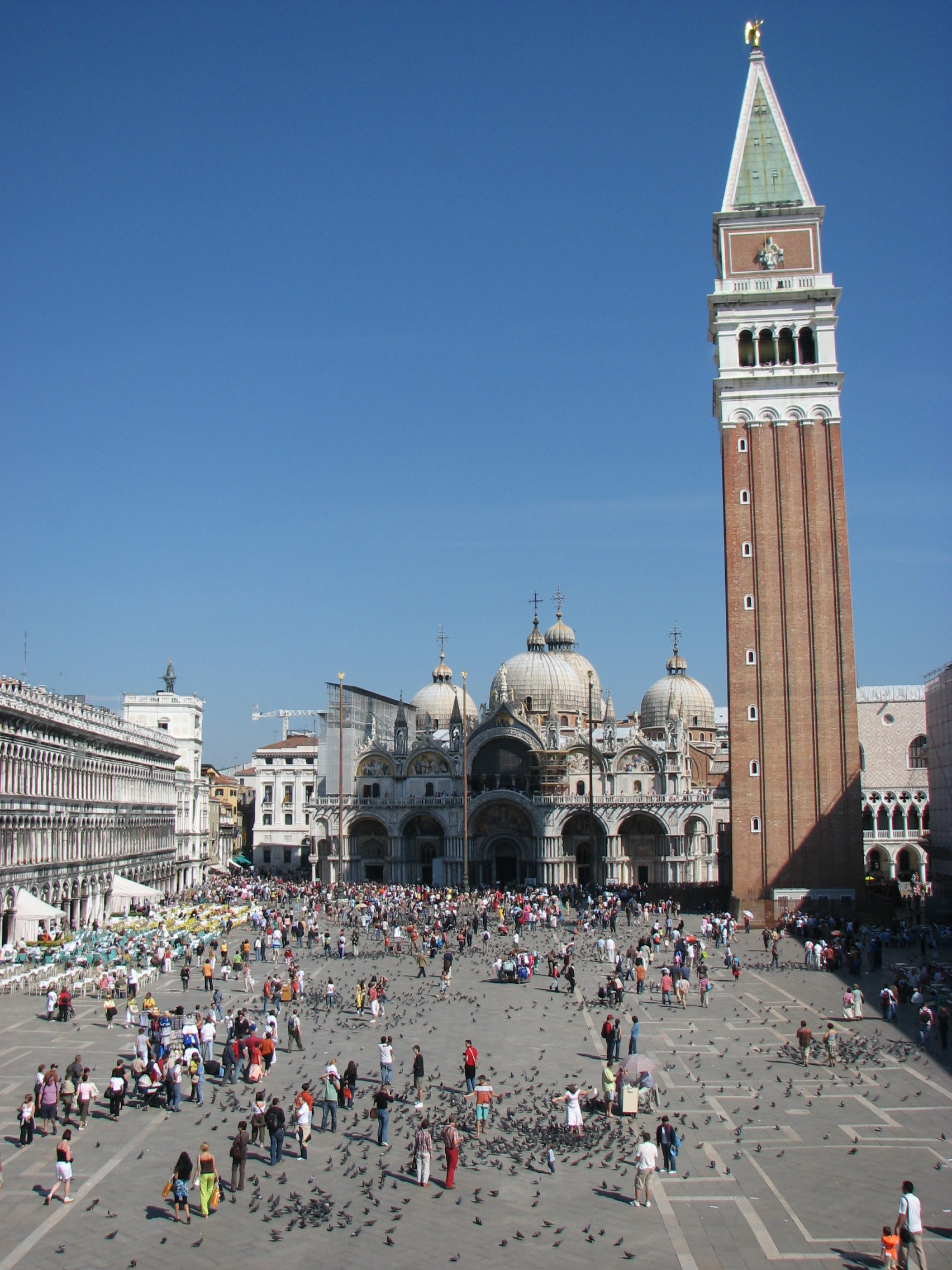


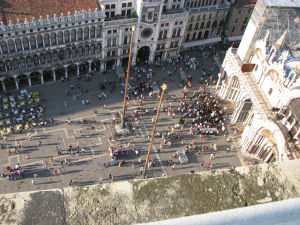
Sunday in Venice and not too many tourist sites open. We walked through the streets towards the Rialto Bridge. We did our best to follow our map and the signs posted on the buildings but soon got turned around. Not a problem in Venice because one can always find a way to an interior canal and then out to the lagoon or the Grand Canal. As we wandered we 
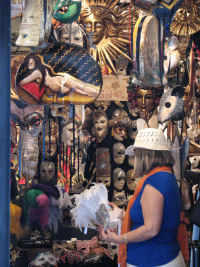
We continued towards the Rialto walking in and out of ‘campos’
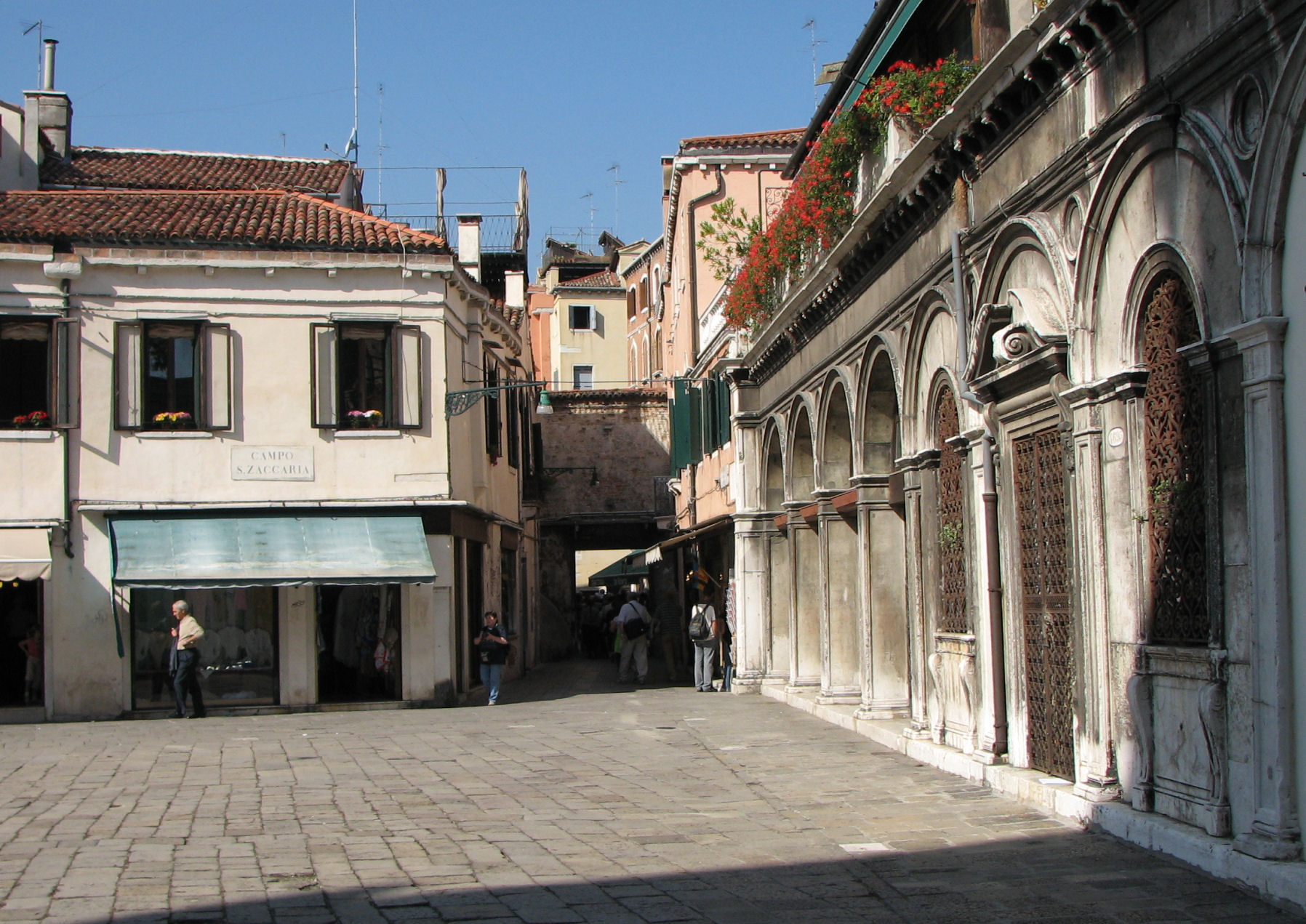
The Rialto Bridge was the first bridge built in Venice and has shops built along the sides of it going over the Grand Canal.
It was packed with tourists so, after walking its length and looking in a few shop windows, 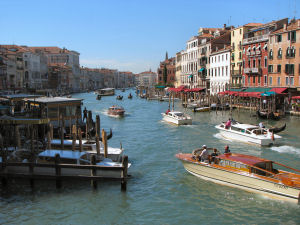
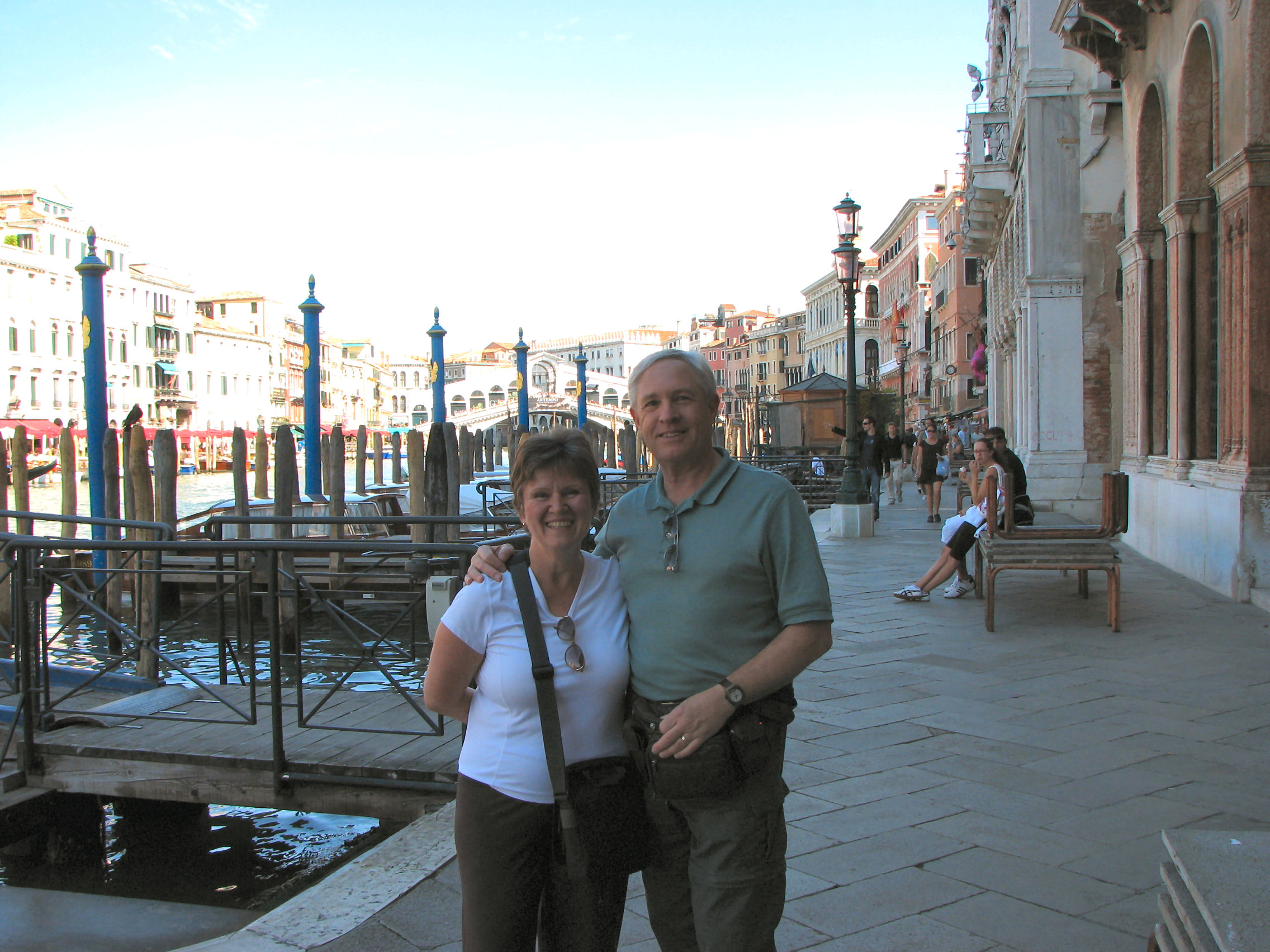
named because it is by the Academy and the Galleria dell’ Accademia, a wooden bridge crossing the Grand Canal.
We found a small café, Café BellArte, where we enjoyed lunch to the antics of a couple of guys who ran the place with Elvis playing loudly over the sound system. Good sandwiches and we all sang along to the Elvis tunes.
At one point the power went off but everyone just kept on singing “…I can’t help falling in love with you.” Great fun.
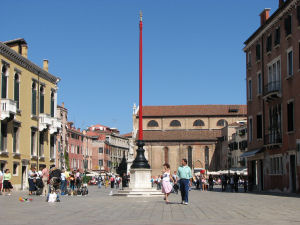
We purchased a 24-hour vaporetto pass and rode around the outside of the main island past the train station where we 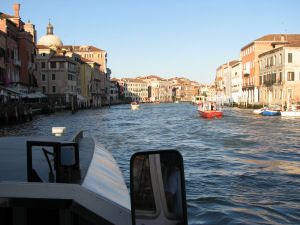
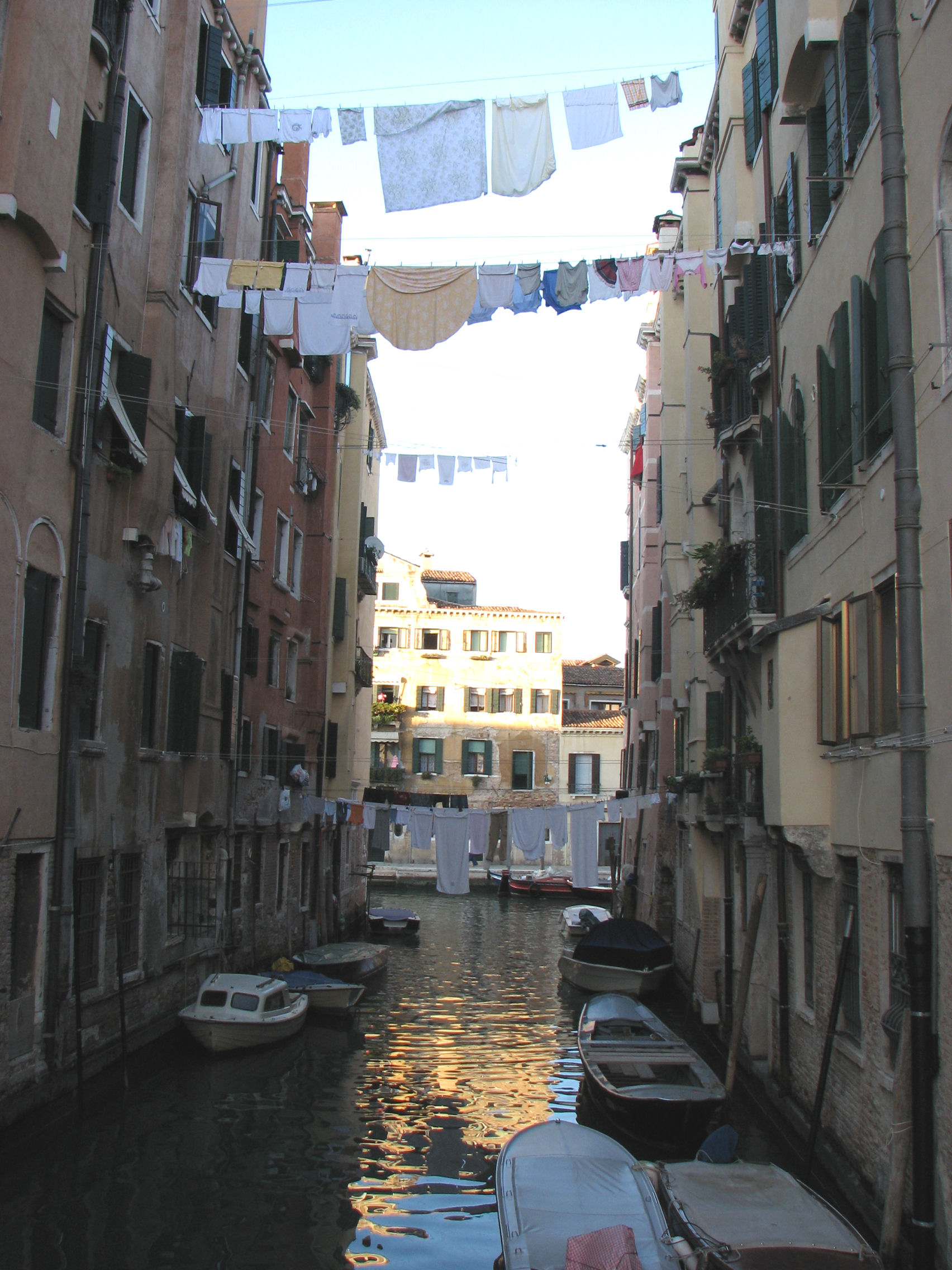
Crossing a narrow bridge and ducking through a small, covered tunnel we entered the Campo di Ghetto Nuovo – the New Jewish Ghetto. In 1516 all of Venice’s Jewish population was forced to live on a small island where the city’s foundry (the “geto”) once was located – and the term
"ghetto" entered our vocabulary.
We came into a square surrounded by old buildings six-stories in height with some greenery in the square.
For the first time in our wanderings we saw children playing and people talking together. A group of Yeshiva students were gathered together outside their school on what was, obviously, a break from their class work. We went into a store and looked at the Judaica, viewed a holocaust memorial set into one wall and then walked back to the vaporetto stop. We boarded and rode around the main island in the gathering twilight and across the lagoon
The Lido is Venice’s outermost island. It acts as a barrier between the Adriatic Sea and the lagoon. It has lots of greenery, sand beaches, casinos and motor traffic.. very unlike the rest of Venice.
It felt as if were back in the States with the cars, busses and motorcycles on wide streets and bright lights. After dinner we rode the vaporetto back across the lagoon in the dark with the lights of Venice glittering and reflecting on the water. Before turning in we sat along the waterfront and enjoyed the sights.
Our last day in Venice and we resolved to see the Doge’s Palace. With our museum pass we by-passed the line andentered a large inner courtyard surrounded by three layers of terraces. Once again, no photography allowed. As we walked through the palace one got a sense of the grandeur of the Venetian Republic which began in the 1300’s. The architecture ran from the Romanesque to Islamic with wonderful facades and frescoed walls and ceilings. Entering up a grand staircase with a frescoed ceiling and plaster carvings and gold-leaf covered frills we moved into a hallway lined with paintings and statues. Wandering from room to room we saw paintings and sculptures by all the Venetian masters. We passed through the armory and then across the Bridge of 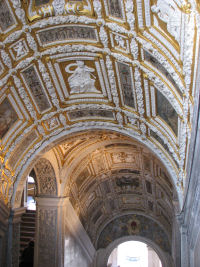
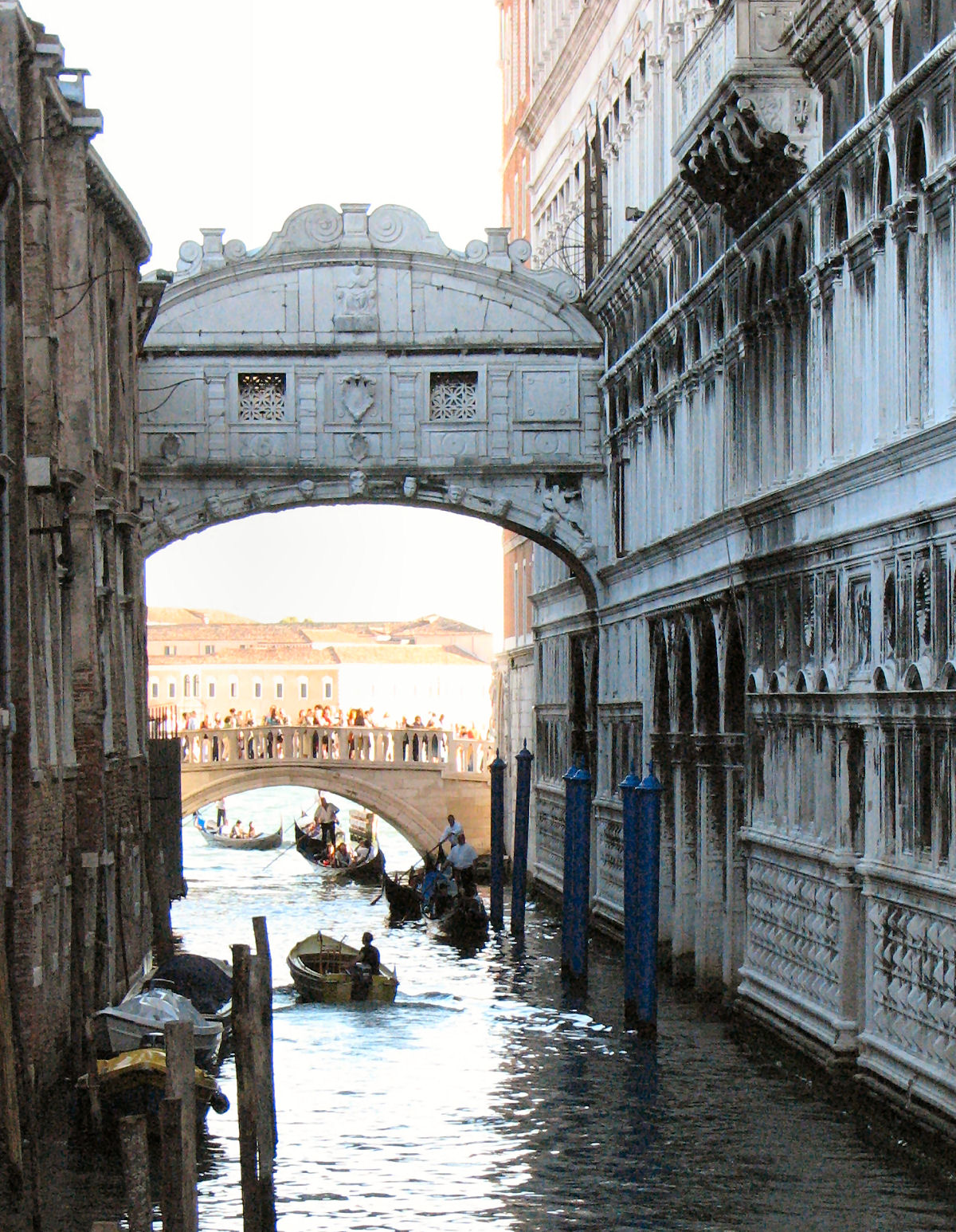
It is said that Cassanova escaped from the Doge’s prison with the help of the warden’s daughter. Back over the bridge and out into the courtyard. The palace was constructed to impress visiting dignitaries- it did us.
We then took a vaporetto up the Grand Canal and just took a last ride to see Venice from the water.
Got off at the St. Thomas stop and walked through the quiet streets of this residential quarter. Ate lunch and kept wandering until we came to a vaporetto stop where we bought gelato and ate it while watching boats pass by.
In the later afternoon we walked to St. Mark’s Square to visit The Basilica Di San Marco. It is a most unusual church, almost Byzantine. The ceiling and the wall decorations are all done in mosaic with gold predominating as the background. The floor undulated beneath our feet with beautiful marble mosaics of many different patterns and colors.
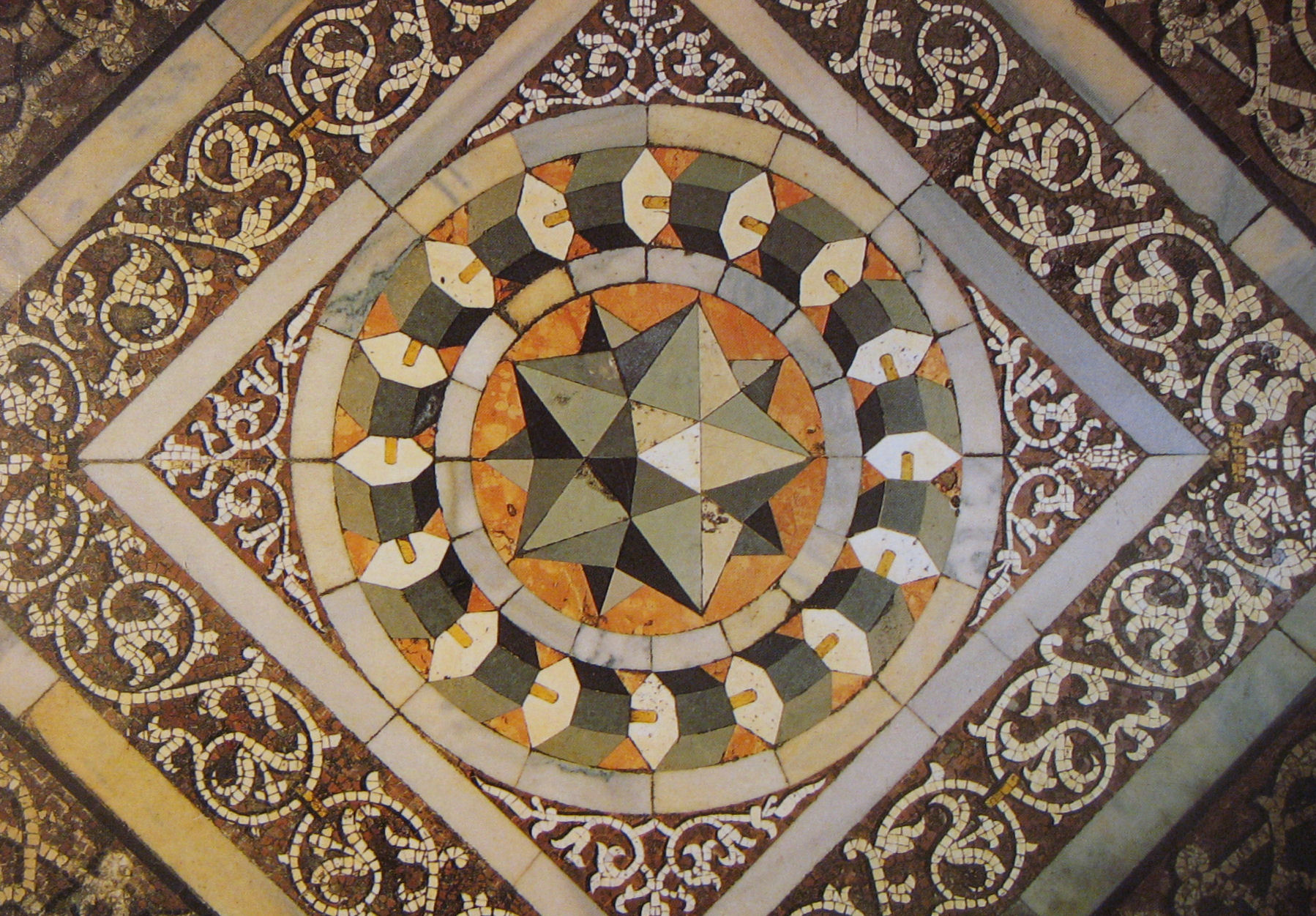
The Doge’s Palace and the Basilica show the wear of the centuries. Being on an island all of Venice is sinking.

The deteriorating condition and the actual sinking downwards of the buildings is continual and the Venetians have major projects in place attempting to stop the sinking and/or repair the damage. In addition, the city floods when the tide and storms combine in a certain way. It used to be a rare occurrence but it now happens every year in October and November. As we walked about the city we often passed sacked platforms that serve as walkways during the flooding. Venice has also suffered several major floods and their marks can be seen on walls throughout the city. The pillars that stand as part of the façade of the Doge’s Palace have sunk to the point where their bases are barely visible.
Back to the hotel to begin packing for the trip to London the next day. One more stroll through St. Mark’s Square to listen to the music and hear the hourly bells. Listening and dancing to the bands prepared us for the final stint of packing.
Up early, took a final stroll along the waterfront before breakfast and before the hordes of tourists crowd it. We watched 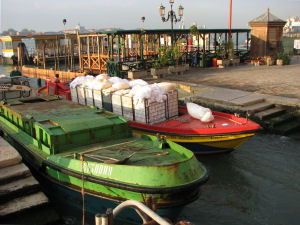
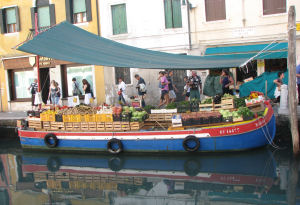
At 9:15 the bellboy came for our luggage and we crossed over to the vaporetto stop where we would pick up the boat to the airport which is located on the mainland.
Checking in was fairly easy but the security checkpoint found a problem. While packing we had put the two bottles of Italian Brunello wine into a carry on to keep them safe, completely forgetting about the TSA regulations. Well – the authorities were very nice about it. They gave us the opportunity to go back to the ticket counter and check through the carry-on with the wine as baggage. They even stamped our boarding passes with a ‘priority’ marking so we would not have to wait in the long TSA line. After a short wait we were off to London.
Arriving at Gatwick, there was our friend, Ray Humby, waiting for us. The next day Ray and his wife, Val, drove us into 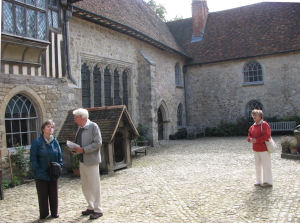
The next day we visited the house that Charles Darwin purchased after returning from his adventures on “The Beagle.” It was here that he pondered and worked on his notes and wrote his book “The 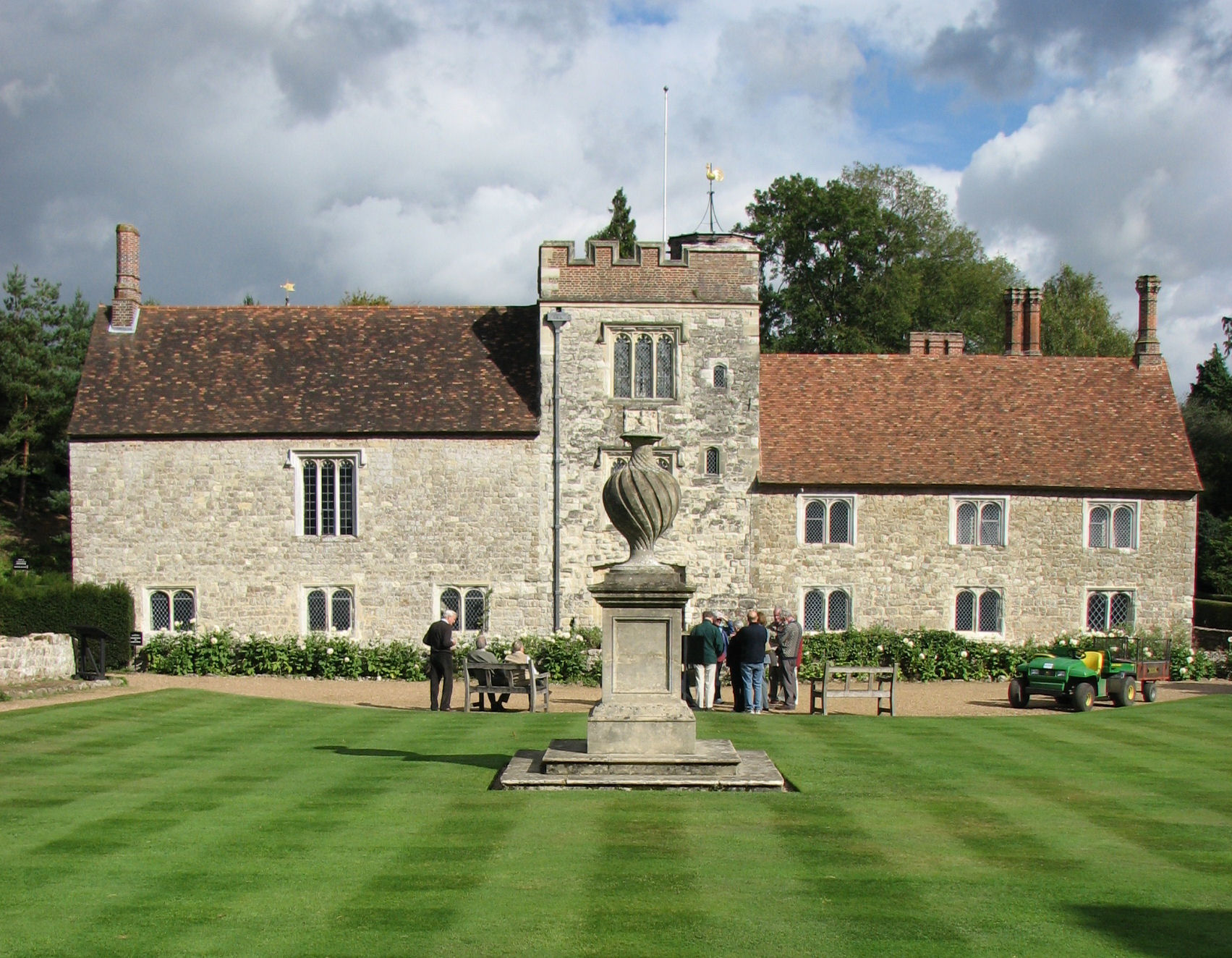
Morning found us at Heathrow Airport before the sun was up. We wandered the shops, ate breakfast and then boarded an Air France plane to Paris where we would change planes and fly directly to LAX.
A long flight but we did have some terrific views of Greenland as we flew over the island. At LAX we caught the Airporter back to Ventura and there were Elaine and Eve waiting to greet us and welcome us home.
We found the Tuscan Italians warm and hospitable, the scenery gentle and soothing. We could not walk anywhere that was not thoroughly steeped in thousands of years of history and, if the old adage that “armies travel on its stomach” has any credence, Italian armies travelled well and contentedly. Venice is a charming city crumbling about one as you stroll its narrow lanes.
Italy will see us again and we will be returning to Tuscany. A most delightful trip.